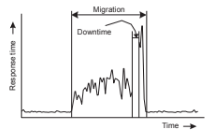FINALS- Distributed Computing
1/47
There's no tags or description
Looks like no tags are added yet.
Name | Mastery | Learn | Test | Matching | Spaced |
|---|
No study sessions yet.
48 Terms
Virtual Processes
Built in software, on top of physical processors.
Processor
Provides a SET OF INTRUCTIONS along with the capability of automatically executing a series of those intructions
Thread
A MINIMAL SOFTWARE PROCESSOR in whose context- a series of instructions can be executed. Saving a thread context implies stopping the current execution and saving all the data needed to continue the execution of a later stage.
Process
A SOFTWARE PROCESSOR — in whose context — ONE OR MORE THREADS MAY BE EXECUTED. Executing a thread means executing a series of instructions in the context of the thread.
Introduction to threads
Thread is the unit of execution within a process performing a task.
A process can have single or multiple threads.
When a process starts, memory and resources are allocated which are shared by each thread
in a SINGLE-THREADED process, both the process and thread are same.
a SINGLE-THREADED process can perform one task at a time
A MULTI-THREADED process can perform multiple tasks at the same time.
Introduction to threads - How do you think can we make a processor truly multiple tasks parallelly?
In relation to hardware, add more CPUs ( servers with multiple CPU sockets)
All the modern processors are multi-core processors, meaning, a single physical processor will have more than one CPU in it.
MULTI-CORE PROCESSORS are capable of running more than one process or thread at the same time. Example, a quad-core processor has 4 CPU cores, it can tun 4 processes or threads at the same time in parallel (PARALLELISM)
Contexts
Allow pausing and resuming without losing data
Processor Context
The minimal collection of value STORED IN THE REGISTERS OF A PROCESSOR USED FOR THE EXECUTION OF A SERIES OF INTRUCTION. (eg. stack pointer, addressing registers, program counter.)
Thread Context
The minimal collection of value STORED IN REGISTERS AND MEMORY, USED FOR THE EXECUTION OF A SERIES OF INSTRUCTIONS. (eg, processor context, thread state — running/ waiting/ suspended)
Process Context
The minimal collection of values STORED IN REGISTERS AND MEMORY, USED FOR THE EXECUTION OF A THREAD. (eg. thread context, but now also at least memory management information such as Memory Management Unit (MMU) register values.)
Observations
Threads share the same address space. THREAD CONTECT SWITCHING can be done entirely independent of the operating system.
Process switching is generally (somewhat) MORE EXPENSIVE as it involves getting the OS in the loop. i.e., trapping to the kernel.
Creating and destroying THREADS is much CHEAPER than doing so for processes.
THREADS
Lightweight units of execution that allow efficient multitasking within a process
PROCESSES
Havier, independent units of execution that require more overhead for creation, switching and destruction.
WHY USE THREADS?
AVOID NEEDLESS BLOCKING- a single-threaded process will block when doing I/O; in a MULTI-THREADED PROCESS, the operation system can SWITCH THE CPU TO ANOTHER THREAD IN THE PROCESS.
EXPLOIT PARALLELISM - The THREADS IN A MULTI-THREADED PROCESS CAN BE SCHEDULE TO RUN IN PARALLEL on a multiprocessor or multicore processor.
AVOID PROCESS SWITCHING- structure large applications NOT AS A COLLECTION OF PRCESSES, but through MULTIPLE THREADS.
AVOID PROCESS SWITCHING
avoid EXPENSIVE context switching
Treade-offs:
Threads use the same address space: MORE PRONE TO ERRORS
No support from OS/HW to protect threads using each other’s memory.
Threads context switching may be faster than process context
Threads And Operating Systems
Main Issue:
Should an OS kernel provide threads, or should they be implemented as user-level package?
User-space Solution
Threads are managed by a LIBRARY/USER-LEVEL PACKAGE that the kernel:
All operations can be completely handled WITHIN A SINGLE PROCESS → Implementations can be extremely efficient.
All services provided by the kernel are done ON BEHALF OF THE PROCESS IN WHICH A THREAD RESIDES → If the kernel decides to block a thread, the entire process will be blocked.
Threads are used when there are lots of external events: THREADS BLOCK ON A PER-EVENT BASIS → If the kernel can’t distinguish threads, how can it support signaling events to them?
Kernel solution’
to HAVE THE KERNEL CONTAIN THE IMPLEMENTATION OF A THREAD PACKAGE. This means that all operations return as system calls.
Operations that block a thread are no longer a problem: the KERNEL SCHEDULES ANOTHER AVAILABLE THREAD within the same process.
Handling external events is simple: The KERNEL(WHICH CATCHES ALL EVENTS) schedules the thread associated with the event.
The problem is (or used to be) the LOSS OF EFFICIENCY due to the fact that each thread operation required a trap (system call that causes the CPU to switch from user mode to kernel mode) to the kernel.
**** CONCLUSION-BUT: Try to MIX USER-LEVEL and KERNEL-LEVEL THREADS into a single concept, however, performance gain has not turned out to outweigh the increased complexity.
Lightweight Processes
Basic Idea
Introduce a TWO-LEVEL THREADING APPROACH: LIGHTWEIGHT PROCESSES that can execute.
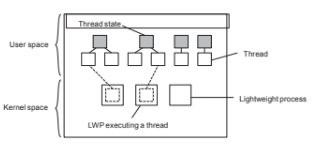
Principle Operation
User-level thread does a system call → THE LWP THAT IS EXECUTING THAT THREAD BLOCKS. The thread remains BOUND to the LWP.
The kernel CAN SCHEDUEL ANOTHER LWP HAVING A RUNNABLE THREAD BOUND TO IT. Note: this thread can switch to ANY other runnable thread currently in the user.
a thread calls a blocking user-level operation → fo a context switch to a runnable thread, (then bound to the same LWP).
When there are no threads to schedule, an LWP may remain idel, and may even be removed( destroyed) by the kernel.

Using Threads At the Client Side
Multithreaded Web Client
Hidinh network latencies:
The web browser scans an incoming HTML page and finds that MORE FILES NEED TO BE FETCHED.
EACH FILE IS FETCHED BY A SEPARATE THREAD. each doing a (blocking) HTTP request.
As files come in, the browser displays them.

Multiple request-response calls to other machines (RPC)
A client does several calls at the same time, each one by a different thread.
it then waits until all results have been returned
Note: If calls are to different servers, we may have a linear speed-up.

Using threads at the Server Side
Improve Performance
Starting a thread is cheaper than starting a new process.
Having a single -threaded server prohibits simple scale-up to a MULTIPROCESS SYSTEM.
As with clients: HIDE NETWORK LATENCY by reacting to the next request while the previous one is being replied.
Better Structure
Most servers have high I?O demands, Using simple, WELL-UNDERSTOOD BLOCKING CALLS simplifies the overall structure.
Multithreaded programs tend to be smaller and easier to understand due to SIMPLIFIED FLOW OF CONTROL.
Why Multithreading is Popular:
ORGANIZATION
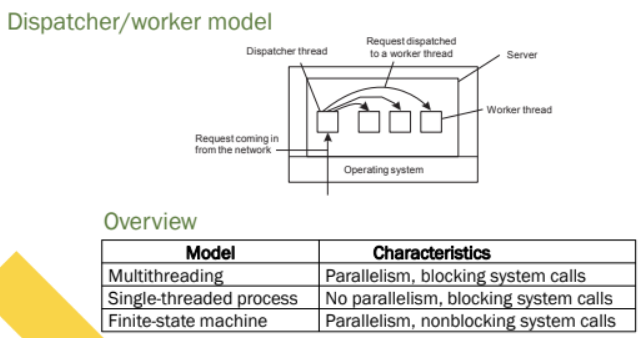

VIRTUALIZATION
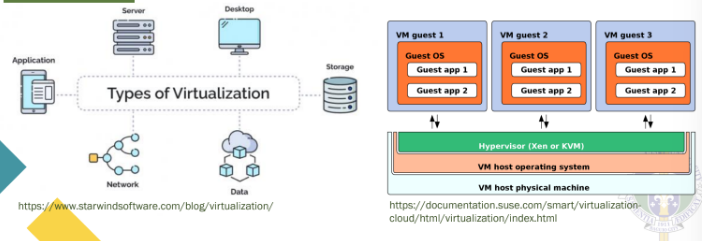
Observation | Virtualization is important:
Hardware CHANGES FASTER than software
Ease of PORTABILITY and close migration
ISOLATION of failing or attacked components
Principles: Mimicking Interfaces
Simulating HARWARE OR SOFTWARE interfaces in a virtual environment.

Mimicking Interfaces
Interfaces at three different levels
Instruction set architecture: the set of MACHINE INSTRUCTIONS, with two subsets:
PRIVILEGED instructions: allowed to be executed only by the operating system.
GENERAL instructions: can be executed by any program.
SYSTEM CALLS as offered by an operating system.
LIBRARY CALL- known application programming interface (API)
WAYS OF VIRTUALIZATION
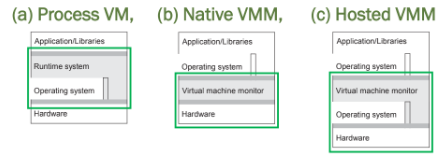
Differences:
a) Platform-independent; a separate set of instructions - an interpreter/emulator, RUNNING ATOP AN OS
b) Has DIRECT ACCESS TO HARDWARE; Low-level instructions, along with bare-bones MINIMAL OS INSTRUCTIONS.
c) RUNS ON TOP OF AN EXISTING OS; may be slower than native VMM due to an EXTRA OS LAYER.

ZOOMING INTO VMs: PERFORMANCE
Refining the Organization
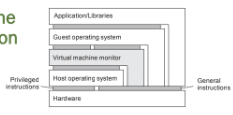
PRIVILEGED INSTRUCTION: if and only if executed in user mode, if causes a TRAP TO THE OS (switch control from user to kernel mode for the OS to perform a PRIVILEGED OPERATION on behalf of the user program)
NONPRIVILEGED INSTRUCTIONS: the rest
SPECIAL INSTRUCTIONS
Control-sensitive instruction: may affect the configuration of a machine, may trap (e.g. one affecting relocation register or interrupt table.)
Behavior-sensitive Instruction: effect is partially determined by the system context (e.g., POPF sets an iterrupt-enable flag, but only in system mode)

Condition for Virtualization
Necessary Condition
For any convention computer, a virtual machine monitor may be constructed if the set of SENSITIVE INSTRUCTIONS for the computer is a SUBSET OF THE SET OF PRIVILEGED INSTRUCTIONS.
Problems: THE CONDITION IS ALWAYS SATISFIED
There may be sensitive instructions that are executed in user mode without causing a trap to the operating system.
Solutions
EMULATE all instructions
WRAP NONPRIVILLEGED SENSITIVE INSTRUCTIONS to divert control to VMM
PARAVISUALIZATION: modify guest OS, either by preventing nonprivileged sensitive instructions, or making them nonsensitive (i.e, changing the context).
Guest OS users make hypercalls for privileged operations.
Virtual Machines And Cloud Computing
THREE TYPES OF CLOUD SERVICES
INFRASTUCTURE-AS-A-SERVICE(IaaS) : Covering the basic INFRASTRUCTURE.
Instead of renting out physical machines, a cloud provider will rent out VM ( or VMM) that may possibly be SHARING A PHYSICAL MACHINE WITH OTHER CUSTOMERS → ALMOST COMPLETE ISOLATION BETWEEN CUSTOMERS (although performance isolation may not be reached)
PLATFORM-AS-A-SERVICE (PaaS): covering SYSTEM-LEVEL services
SOFTWARE-AS-A-SERVICE (SaaS): containing actual APPLICATIONS
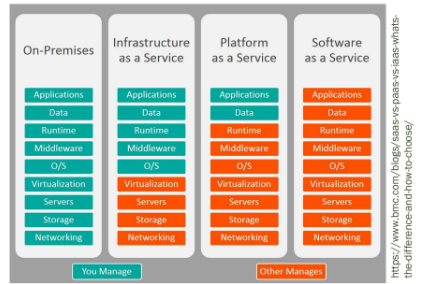

Client-Server Interaction
Distinguish application-level and middleware-level solutions

APPLICATION LEVEL
Each new application must implement ist OWN PROTOCOL LOGIC, leading to higher development effort and less reuse
MIDDLEWARE LEVEL
Promotes code reuse, interoperability, and simplifies development by ABSTRACTING NETWORK details from the application

ex: The X Window System
Basic Organization
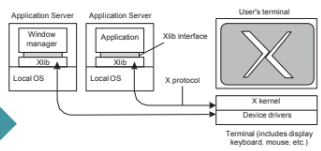
The client app (on a remote machine) uses XLib to communicate.
It sends GUI commands over the X protocol to the X server.
the X server renders graphics and sends back user input (keyboard/mouse) events.
X client and server
The application acts as a client to the X-kernel, the latter running as a server on the client’s machine.

Improving X
Practical Observation
There is a often NO CLEAR SEPARATION between application logic and user-interface commands (mixed)
Application tend to operate in a tightly SYNCHRONOUS manner with X kernel (affects performance -waits for responses)
Alternative Approaches
Let applications control the display completely, up to the pixel level (e.g., VNC)
Provide only a few high-level display operations ( dependent on local video drivers), allowing more efficient displays operations.
Client-side software
Generally tailored for distribution transparency
Access transparency: Conceal resource access using client-side stubs for RPCs
Location/ migration transparency: conceal resource location and let client-side software keep track of the actual location
Replication transparency: multiple invocations handled by the client stub:

Failure transparency: can often be placed only at the client ( mask server and communication failures).

SERVER: GENERAL ORGANIZATION
Basic model
A process IMPLEMENTING A SECIFIC SERVICE on behalf of a collection of client. It waits for an incoming request from a client and subsequently ENSURE THAT THE REQUEST IS TAKEN CARE OF, after which it waits for the next incoming request.
CONCURRENT SERVERS
ITERATIVE SERVE
The server handles the request before attending to the next request.
CONCURRENT SERVER
Uses a dispatcher, which picks up an incoming request that is then passed on to a SEPARATE THREAD/PROCESS. it can handle multiple request in parallel ( at the same time).
Observation
Concurrent servers are the norm: they can EASILY HANDLE MULTIPLE REQUESTS, notably in the presence of blocking operations ( to disks or other servers).
Contracting a server
observation:
Most services are tied to a specific port
DYNAMICALLY ASSIGNING TO AN ENDPOINT
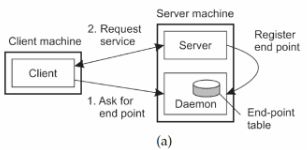
Deamon Registry
The client asks the daemon on the server machine for an available endpoint
The daemon provides the client with the endpoint, and the client uses it to request service from the appropriate server.
The server registers its endpoint with the daemon ( which maintains an endpoint table).
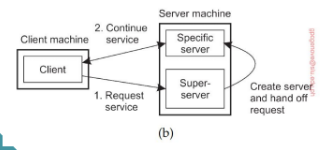
Super- Server Model
The client send a request for service to a super-server
The super server dynamically creates or activates a specific server.
The specific server takes over and continues servicing the client directly
DIAGRAM (A) USES A DEMON to manage and register server endpoints, where the SERVER IS ALWAYS RUNNING AND the CLIENT REQUEST ENDPOINT DYNAMICALLY. This approach suits PERSISTENT SERVICES but can be resource-intensive.
In contrast, DIAGRAM (b) employs a SUPER-SERVER that activates or spawns a specific server only when a client request arrives, making it more resource-efficient and scalable-ideal for ON-DEMAND or multi-service environments.

OUT-OF-BAND COMUNICATION
ISSUE:
Is it possible to interrupt a server once it has accepted (or is in the process of accepting) a service request?
SOLUTION 1: USE A SEPARATE PORT FOR URGENT DATA
server has a separate thread/process for urgent messages
urgent message come in → associated request in put on bold
NOTE: we require OS support priority-based scheduling
SOLUTION 2: USE FACULITIES OF THE TRANSPORT LAYER
example: TCP ALLOWS FOR URGENT MESSAGES in same connection
Urgent massages can be caught using OS signaling techniques.
SERVER AND STATE
STATELESS SERVES
NEVER KEEP ACCURATE INFORMATION about the status of a client after having handled a request:
DON’T record whether a file has been opened (simple close it again after access)
DON’T promise to invalidate a client’s cache
DON’T Keep track of your clients
CONSEQUENCE
Clients and servers are completely independent
State inconsistencies due to client or server crashes are reduced
Possible loss of performance because, for example, a server cannot anticipate client behavior (think of prefetching file blocks)
STATEFUL SERVERS
Keeps TRACK OF THE STATUS of its clients:
Record that a file has been opened, so that prefetching can be done.
knows which data a client has cached, and allows clients to keep local copies of shared data.
Obsercation
The performance of a stateful server can be extremely high, provided clients are allowed to keep local copies. As it turns out, reliability is often not a major problem. However, this may be harder to scale.
COMPARISON
SATELESS SERVERS:
DO NOT RETAIN ANY INFORMATION about client interactions between requests, treating each request as independent and self-contained
highly scalable, easier to manage, and fault-tolerant —ideal for RESTful APIs and services, like DNS, could be inconsistent.
STATEFUL SERVERS:
MAINTAIN SESSION INFORMATION across request, useful for more personalized and content-aware interactions, such as in online banking, shopping carts, or gaming.
harder to scale and less resilient to failures, often requiring more complex infrastructure to manage session state.
THREE DIFFERENT TIERS
COMMON ORGANIZATION
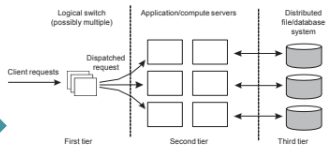
Per tier:
Client requests first hit a logical switch or load balancer. The switch distributes the requests among multiple servers.
Each server process business logic, performs computations, or prepares requests for the backend.
Handles data persistence, retrieval and updates.
Crucial Element
The FIRST TIER generally responds to passing requests to an appropriate server: REQUEST DISPATCHING

REQUEST HANDLING
Observation:
Having the first tier handle all communication from/to the cluster MAY LEAD TO A BOTTLENECK. Imagine only one load balancer.
Solution: TCP HANDOFF
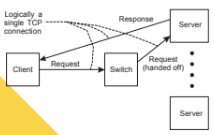
With the TCP handoff:
The selected SERVER TAKES OVER the connection and continues communication with the client.
The server processes the request and SENDS A RESPONSE DIRECTLY to the client.
From the client’s perspective, it feels like a SINGLE CONTINUOUS CONNECTION.

SERVER CLUSTERS
The front end may easily get overloaded: Special measures may be needed
TRANSPORT-LAYER Switching: Front end simply passes the TCP request to one of the servers, taking some PERFORMANCE METRIC into account.
CONTENT-AWARE DISTRIBUTION: front end reads the content of the request and then selects the BEST SERVER.


WHEN SERVERS ARE SPREAD ACROSS THE INTERNET
Observation:
Spreading servers across the internet may introduce Administrative problems. these can be largely circumvented by using data centers from a single cloud provider.
Request dispatching: IF THE LOCALITY IS IMPORTANT
Common approach: use DNS
Clients looks up specific service through DNS— client’s IP address is part of the request
DNS server keeps tracking of replica servers for the requested service, and RETURND THE ADDRESS OF MOST LOCAL OR NEAREST SERVERS.
CLIENT TRANSPARENCY
to keep the client unaware of distribution, le the DNS resolve act on behalf of the client. the problem is that the resolver may actually be far from local to the actual client.
DISTRIBUTED SERVERS WOTH STABLE IPv6 ADDRESS(es)
Transparency through Mobile IP
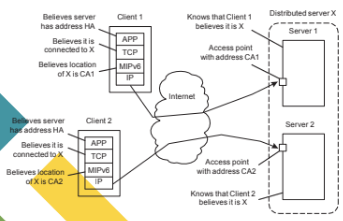
ROUTE OPTIMIZATION can be used to make different clients believe they are COMMUNICATING WITH A SINGLE SERVER, where, in fact, each client is communicating with a different member node of the distributed server
When a distributed server’s access point forwards a request from client C1 to serve node S1 (with care-of address CA1), it INCLUDES ENOUGH INFORMATION FOR S1 TO BEGIN A ROUTE OPTIMIZATION PROCESS.
This process makes C1 believe that CA1 is the server’s current location, allowing C1 to store the pair (HA,CA1) for future communication. The ACCESS POINT AND THE HOME AGENT TUNNEL MOST OF THE TRAFFIC, ENSURING THE HOME AGENT DOES NOT DETECT A CHANGE IN THE CARE-OF ADDRESS
As a result, the HOME AGENT continues to communication with the original access point, maintaining SESSION CONTINUITY.

DISTRIBUTED SERVER: ADDRESSING DETAILS
Essence: Client having MobilelPv6 can transparently set up a connection to any peer
Client C set up connection to IPv6 HOME ADDRESS(HA)
HA is maintained by a (network-level) home agent, which hands off the connection to a registered CARE-OF ADDRESS CA.
C can then apply ROUTE APTIMIZATION by directly forwarding packets to address CA (i.e., without the handoff through the home agent).
Collaborative distributed systems
Origin server maintain a home address, but HAND OFF CONNECTIONS TO THE ADDRESS OF COLLABORATING PEER→ ORIGIN SERVER AND PEER APPEAR AS ONE SERVER.
EXAMPLE: PLANET LAB
Essence:
Different organizations contributes machines, which they subsequently share for various experiments.
PlanetLab was a global research network that allowed researchers to test new protocols and services on a real-world, wide-area network. Ot consisted of hundred of nodes(servers) hosted by universities and research institutions around the world.
PROBLEM:
We need to ensure that different distribution do not get into each other’s way → Virtualization.
Basic Organization
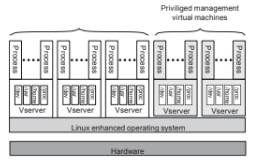
Vserver
Independent and protected environment with its own libraries, server versions, and so on. Distributed applications are assigned a COLLECTION OF Vservers distributed across multiple machines.
PlanetLab VServers and Slices
Essence
Each Vserver operates in its own environment.
Linux enhancements include proper adjustment of process.
Teo process if DIFFERENT VSERVERS MAY HAVE SAME USER ID< BUT DOES NOT IMPLY THE SAME USER.
Separation Leads to slices:
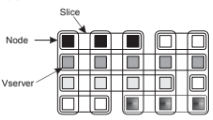

REASON TO MIGRATE CODE
Load Distribution
Ensuring that servers in a data center are sufficiently loaded(e.g., to prevent waste of energy)
Minimizing communication by ensuring that COMPUTATIONS ARE CLOSE TO WHERE THE DATA IS (think of mobile computing).
Flexibility: moving code to a client when needed
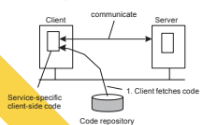
Code migration is the process of moving executable code from one machine to another in a distributed system to improve performance, efficiency, or flexibility.
Avoids pre-installing software and increases dynamic configuration.

Models For code migration
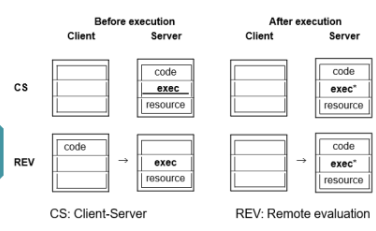
client-server
The client sends a request to a server. The server processes the request locally and sends back the result.
CODE STAYES PUT, only data moves between client and server
Remote Evaluation
The client sends code to the server to be executed there. Useful when the server has more data or resources.
CODE MOVES FROM CLIENT TO SERVER.
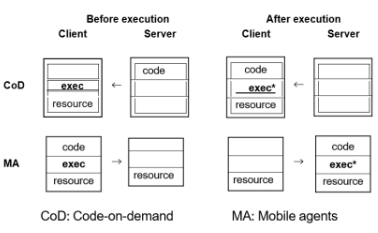
Code on Demand
The server SENDS CODE TO THE CLIENT, where it’s executed. Often used when clients need dynamic behavior or updates.
CODE MOVES FROM SERVER TO CLIENT.
Mobile Agents
A MOBILE AGENT (code + execution state + data) moves from host to host, executing part of its task at each.
CODE AND STATE MOVE BETWEEN SYSTEMS.

STRING and WEAK MOBILTY
Object Components in Code Migration
Code segment: contains the actual code
Data segment: contains the state
Execution state: contains the context of the thread executing the object’s code
Weak mobility: Move code and data segment ( and reboot execution)
Relatively simple. especially if the code is portable
Distinguish code shipping(push) from code fetching(pull)
Strong mobility: Move component, including execution state"
Migration: move the entire object from one machine to the other.
Cloning: start a clone, and set it in the same execution state.
Migration in HETEROGENEOUS SYSTEM
Main Problem:
The target machine may not be SUITABLE TO EXECUTE THE MIGRATE CODE
The definition of process/thread/processor context is HIGHLY DEPENDENT ON LOCAL HARDWARE, OPERATING SYSTEM AND RUNTIME SYSTEM.
Only Solution: ABSTRACT MACHINE IMPLEMENTED ON DIFFRENT PLATFORMS
Interpreted language, effectively having their own VM
Virtual machine monitors
Migrate entire virtual machine including (OS and processes)
Migrating a virtual machine
Migrating images: three alternatives
pushing memory pages ( unit of memory management) to the new machine and RESENDING THE ONES THAT ARE LATER MODIFIED during the migration process.
STOPPING the current virtual machine; MIGRATING memory, and processes start on the new virtual machine
Letting the new virtual machine PULL IN NEW PAGES AS NEEDED: processes start on the new virtual machine immediately and copy memory pages on demand.
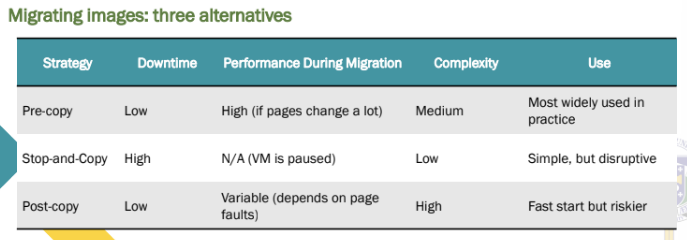

Performance of migrating virtual machine
Problem
A complete migration may actually take tens of seconds. we also need to realize that during the migration, a service will be completely unavailable for multiple seconds.
Measurements regarding response times during VM migrations
